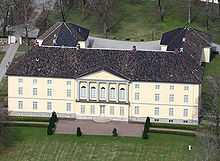Herman Wedel Jarlsberg
| Count Wedel Jarlsberg | |
|---|---|
 | |
| Governor of Norway | |
| In office 1836–1840 | |
| Monarch | Karl III Johan |
| Preceded by | Baltzar von Platen |
| Succeeded by | Severin Løvenskiold |
| Personal details | |
| Born | 21 September 1779 Montpellier France |
| Died | 27 August 1840 Wiesbaden, Germany |
| Nationality | Norwegian |
| Spouse(s) | Karen Anker |
Johan Caspar Herman Wedel Jarlsberg (21 September 1779 – 27 August 1840) was a politician and a Norwegian count. He played an active role in the constitutional assembly at Eidsvoll in 1814 and was the first native Norwegian to hold the post of governor (representing the absent king as head of the Norwegian cabinet) during the union with Sweden.[1]
Background
Wedel Jarlsberg was born in Montpellier, France, son of Diplomat Frederik Anton Wedel-Jarlsberg (1748–1811) and Catharina Storm (1756–1802). He studied law in Copenhagen and graduated in 1801. He accepted a commission as the king's official for the district of Buskerud in 1806.
Career
During the Napoleonic Wars, his connections with Sweden increased, and when the appointed and adopted Swedish crown prince, Carl August died in 1810, his name was mentioned as a possible substitute in a desperate situation. Jean Baptiste Bernadotte was appointed and adopted and changed his name to Carl Johan.
Wedel-Jarlsbergs engagement for a Norwegian union with Sweden did not diminish. He maintained strongly that Norwegian interests were often contrary to the Danish, and that after the Swedes had adopted a constitution in 1809, Norwegian interests would be more strongly secured in a union with that country. He was of course well aware of the Swedish campaign to incorporate Norway as a substitution for the lost Finnish provinces. In some popular works count Wedel-Jarlsberg has been described as a traitor – a fifth-columnist – which is completely unjust. His opinions were well known to the educated public, and even if he was politically isolated to some extent, his title and position in the Norwegian society never changed much.
During Norway's efforts to secure independence from Denmark and Sweden in 1814, he hence advocated a moderate approach to the issue. He was the obvious leader of the party which has been named "the Swedish Party" or "the Negotiation Party". He maintained that Norway would not manage to stand completely alone, alienated from all the leading powers in Europe, which had unanimously guaranteed Norway as a Swedish province. But there is no evidence that his point of view in any sense prevented him from fighting for a Norwegian constitution inspired by those of the United States and France, which the Swedish constitution was not. He belonged to the minority in the main topic on the Constitutional Assembly at Eidsvoll, but he was vindicated by subsequent events.
He was made minister of finance in 1814 and served in this role until 1822. His efforts to restore a Norwegian monetary policy were successful, and he was without contest as the leading force of the government – even with Swedish governors as the formal leaders of the cabinet. His relations with king Carl Johan had at that time cooled to a point where close cooperation was no longer possible. He was elected to Stortinget in 1824, where he served until 1832. He was president of parliament twice, in 1824 and 1830, and in 1836, after relations with the king had improved again, he was appointed governor and held that post until his death in Wiesbaden in 1840. The choice of him as governor was a popular one. He was almost unanimously respected because of his obvious political and administrative talents. His status as a nobleman in a country where nobility had been abolished as early as in 1821 (those wearing a title were still maintaining them, but no new titles would ever be given or inherited), did not diminish the Norwegians' affection for him. It is beyond doubt that his contributions to diminish the rather aggressive relations between the Parliament – the Storting – and king Carl Johan were decisive.
Personal life

Wedel Jarlsberg was married to Karen Anker, the only child of prime minister Peder Anker. From her family he inherited a vast fortune, consisting mostly of the forests around Christiania – present day Oslo. In 1812, Johan Caspar Herman Wedel Jarlsberg rebuilt the manor house at Jarlsberg (Jarlsberg hovedgård) in the empire style. Around the manor there were arranged big, but simple garden and parks areas.[2]
References
Online sources
*Barton, Hildor Arnold (2003). Sweden and visions of Norway: politics and culture, 1814–1905. SIU Press. ISBN 0-8093-2441-5. Retrieved 16 November 2009.
External links
| Preceded by Baltzar von Platen |
Governor of Norway 1836–1840 |
Succeeded by Severin Løvenskiold |
|